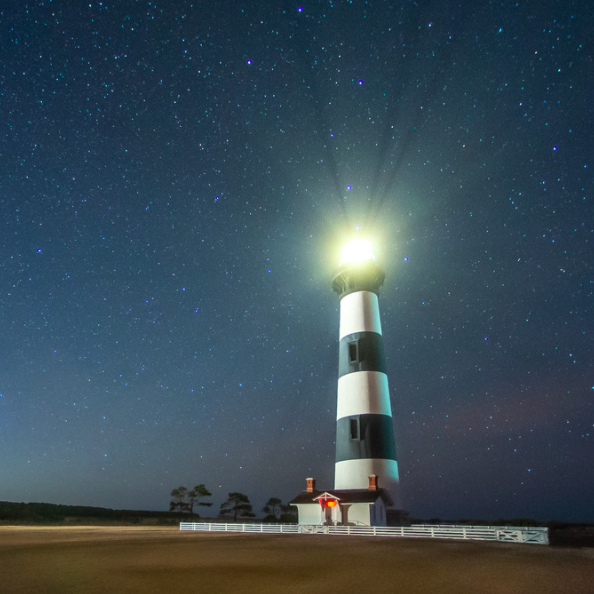The Graveyard of the Atlantic has claimed countless ships and lives off the coast of North Carolina. Since 1872, the Bodie Island Lighthouse has warned mariners of the hidden dangers which lie 40 miles to the south, the Diamond Shoals. Ships taking advantage of the southern-flowing Labrador Current were alerted by the light that it was time to begin veering east. The Mariners needed to “thread the needle” by easing off the coast far enough to get out of the Labrador Current, but not so far as to enter the northern-flowing Gulf Stream.
The current tower seen today is on the National Register of Historic Places and is the third lighthouse to serve this area. It stands nearly 165 feet tall, has a floating staircase containing 219 steps, and still possesses its original first order Fresnel lens. Since being electrified in 1932, the flashing pattern of 2.5 seconds on, 2.5 seconds off, 2.5 seconds on, 22.5 seconds off can be seen 19 miles away at night. It is also recognizable after the sun rises by its bold daymark of black and white horizontal bands.
This year on October 1, the Bodie Island Lighthouse will celebrate 150 years of illumination. Since it was first lit, the lighthouse has been continually cared for. The resilient keepers of the U.S. Lighthouse Board occupied a remote position that required constant hard work. The last principal keeper, Lloyd Vernon Gaskill, would go on to continue his service with the U.S. Coast Guard (USCG) when they became the stewards of the lighthouse in 1939. The USCG transferred the light station grounds to the newly established Cape Hatteras National Seashore in 1953 but kept control of the tower for another 47 years.
Today, the Bodie Island Lighthouse is cared for and operated by the National Park Service. After undergoing a major restoration in 2013, the lighthouse was opened to the public for climbing. You can celebrate 150 years of history by joining park staff at Bodie Island, Outer Banks Forever, and the Outer Banks Lighthouse Society on October 1 on the lighthouse grounds for a special event! Click here for details.
Adapted from the National Park Service. Originally published in the 2022 edition of the Outer Banks Group’s “In the Parks” newspaper.

